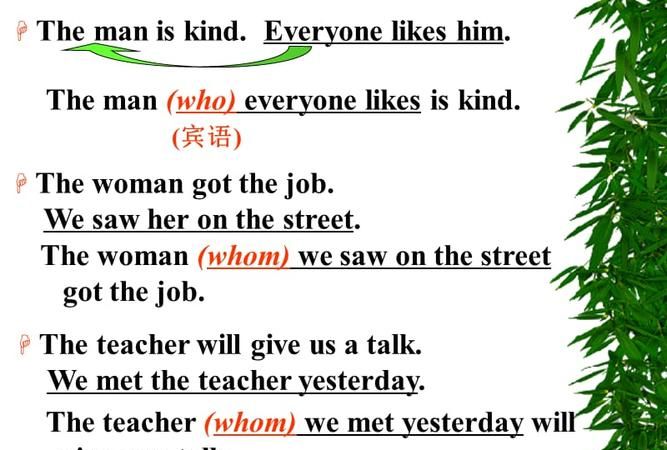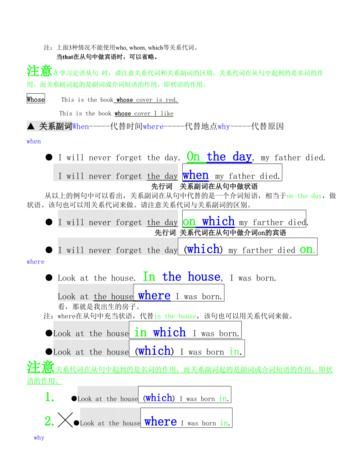本文目录
in the dark street there wasnt
In the dark street 为地点状语, there wasn't a single person to whom she could turn for help为存现句型,其中a single person 为存现句的表语,to whom 引导定语从句,to为turn to这一固定短语中的介词提前,放在whom之前修饰连词.

where who which 引导的定语从句
一、名词性从句名词性从句主要分为四大类:主语从句、宾语从句、表语从句和同位语从句。<一>主语从句 1.that引导的主语从句 that引导的主语从句既可以放在句首也可以放在句末,在实际应用中我们常常采用it形式主语的形式。 例句:That he passed the English test is true. 千真万确,他通过了英语考试。 →It is true that he passed the English test. 2.形式主语的四个主要句型 (1)It + be + 名词 + that从句 例:It is a pity that…可惜的是 可应用于此句型的名词还有fact / shame / honor / question等。 (2)It + be + 形容词 + that从句 例:It is certain that… 很肯定 可应用于此句型的形容词还有clear / better / natural / important 等。 (3)It + be + 动词的过去分词 + that从句 例:It is said that…据说 可应用于此句型的过去分词还有believed / known / reported等。 (4)It + 不及物动词 + that 从句 例:It seems that…好像是 可应用于此句型的不及物动词还有happen / appear 等。 3.wh-引导的主语从句 例句:Where we will go hasn’t been decided. 我们要去哪儿还没定下来。<二>宾语从句 1.that引导的宾语从句 that常用来引导宾语从句,通常that可以省略。 例句:He has told me that he will go to Shanghai tomorrow. 他已经告诉我他明天要去上海。 注意:在demand、order、suggest、decide等表示要求、命令、建议、决定等意义的动词后,that从句常用“(should) + 动词原形”的结构(参考“虚拟语气”部分)。 2.wh-引导的宾语从句 例句:I want to know what he has told you. 我想知道他告诉了你什么。 3.形容词后面所跟的宾语从句 某些动态形容词(afraid、confident、aware、certain、sure、doubtful等)在句中做表语时,后面可跟宾语从句。 例句:I am confident that I can get the job. 我有信心我可以得到这份工作。<三>表语从句 1.that引导的表语从句 基本结构:主语 + 系动词 + that从句 例句:The fact is that we have lost the game. 事实是我们已经输了这场比赛。 2.wh-疑问词引导的表语从句 例句:That is why I tell you the news.. 那就是我为什么告诉你这个消息的原因。 3.从属连词as if、because、just as等引导的表语从句 例句:It is because I have ever heard of the story. 那是因为我曾经听说过这个故事。<四>同位语从句同位语从句通常由that引导 可用于同位语从句的名词有advice、demand、doubt、fact、hope、idea、information、message、news、order、problem、promise、question、request、suggestion、truth、wish、word等。 例句:The news that we won the game is exciting. 我们赢得这场比赛的消息令人激动。二、定语从句<一>引导定语从句的关系代词和关系副词 关系词修饰先行词例句关系代词that人 / 物Do you know the man that / who is talking to my brother?
你认识和我哥哥聊天的那个人吗?which物The book that / which I borrowed from John is very interesting.
我从John那借来的书很有趣儿。who人I don’t know the man that / who is waiting for you at the gate.
我不认识在大门口等你的人。whom人The man that / whom you met in the supermarket is Tom’s father.
你在超市遇见的那个人是Tom的父亲。whose人 / 物Do you know the man whose wife is injured in a car accident?
你认识那个在车祸中妻子受伤的人吗?关系副词when时间I will never forget the day when I met you.
我永远忘不了我遇见你的那一天。where地点That is the school where I have studied for 6 years.
那就是我学习了六年的学校。how方式I have forgot the way how to get to the railway station.
我已经忘了去火车站的路。why原因That is the reason why he didn’t come.
那就是他没来的原因。<二>that和which引导定语从句的区别 1.不用that的情况 (1)在引导非限定性定语从句时 例句:He can speak English fluently,which impressed me most. 他的英语讲得很流利,给我留下了深刻印象。 (2) 介词后不能用 例句:This is the house in which I have lived for 2 years. 这就是我居住了两年的房子。 2.只能用that引导定语从句的情况 (1)在不定代词,如:anything, nothing, something, the one, all, much, few, any, little等作先行词时,只用that,不用which。 例句:There is nothing that we can use. 这里没什么我们可用的东西。 (2)先行词有no, the only, the very, some修饰时,只用that。 例句:This is the very man that I want to meet. 这正是我要见的人。 (3)先行词被序数词、形容词最高级修饰时,只用that。. 例句:That is the most important thing that I want to know. 那是我想知道的最重要的事。三、状语从句状语从句的分类及各种连词分类连词例句时间状语从句 after, before, as soon as, since, when, till, while等 I was reading when he entered the room.
当他进来的时候我正在读书。地点状语从句 Where, wherever等 I have put the book where it was.
我已经把书放在原位了。原因状语从句 because, as, since, for等 I don’t want to go because I am tired of any party.
我不想去因为我已经厌倦了任何宴会。条件状语从句 if, unless, as long as, so long as等 If you have known the news, please tell me now.
如果你已经知道了这个消息,请现在告诉我。让步状语从句 though,although,however等 I will not trust you although you have told me the truth.
尽管你已经告诉了我真相,我也不会信任你的。结果状语从句 so that,so…that…, such…that…等 He ran so fast that nobody could catch up with him.
他跑得如此之快,以至于没人能跟上他。目的状语从句 so that, in order that等 I must leave now so that I can catch the last bus.
我必须立刻离开以便我能赶上末班车。方式状语从句 as, just as, as if, as though等 We should do as the teacher told us.
我们应该按照老告诉我们的去做。比较状语从句 as…as…, not so…as, than等 This house is bigger than that one.
这所房子比那所房子大。 历年真题及解析--从句一、名词性从句 1、—I think it is going to be a big problem.—Yes, it could be.—I wonder ______ we can do about it. (北京 2002春季) A、if B、how C、what D、that 答案C 真题解析:本题考察名词性从句的连接词的用法。wonder后面应跟宾语从句,而从句中的谓语动词do是及物动词,可见从句缺少一个代替宾语的成分,我们可以用排除法排除不作成分的if和that,再排除引导方式状语的how,答案是C,句子的意思是“我们能就此做些什么”。2、 ______ is no possibility _______ . Bob can win the first prize I the match. (上海2001春) A、There; that B、It; what C、There; whether D、It; whether 答案A 真题解析:首先确定本句为存现句,因此应该用There be结构;然后从句子的结构和意义两方面分析可知,第二个空需要填一个引导同位语从句的连接词,且possibility为抽象名词,表达了明确的意义,所以用连词that。3、A computer can only do _____ you have instructed it to do. ( NMET 2001)
A、how B、after C、what D、when 答案C 真题解析:本题考察名词性从句连接词的使用。从句子结构可知,句子的空白处应该填引导宾语从句的连词,做主句谓语动词do的宾语,同时该连接词还是从句中的do的宾语,因此,此处的连接词应该用what。二、定语从句 4、 The famous basketball star, _______ tried to make a comeback, attracted a lot of attention. (北京 2002春季) A、where B、when C、which D、who 答案D 真题解析:本题考察定语从句关联词的选择,从句意可知先行词the famous basketball star(著名的篮球明星)是人,所以应用表示人的关联词who。5、 The film brought the hours back to me _____ I was taken good care of in that far-away village.(NMET 2001) A、until B、that C、when D、where 答案C 真题解析:本题考察定语从句的连接词,主句中的先行词the hours被其它成分分割,只要考生能够认清真正的先行词,就不难得出答案,the hours表示时间,所以应该选择一个表示时间的关系副词,即when。6、_____ is known to everybody, the moon travels around the earth once every month. (NMET 2001)
A、It B、As C、That D、what 答案B 真题解析:本题考察as引导非限定性定语从句。as引导从句的意思是“正如……..”,引导的非限定性定语从句修饰整个句子,当as在从句中充当主语时,常用下面的结构:as is know,as is said,as is reported
等,所以本题的答案是B。三、状语从句 7、 John shut everybody out of the kitchen _____ he could prepare his grand surprise for party. (NMET 2002) A、which B、when C、so that D、as if 答案C 真题解析:本题考察so that引导目的状语从句。so that意思是“以便”,整句话的意思是“John把大家关在厨房外,其目的是为了自己能为宴会准备一件让人感到意外的东西。”所以正确答案为C。8、 The man will have to wait all day _____ the doctor works faster. (京皖蒙2001春季) A、if B、unless C、whether D、that 答案B 真题解析:本题考察unless引导条件状语从句。unless意思是“除非”,根据句意“这个人要等上整整一天,除非医生能够快一些。”所以答案选unless。9、The WTO can’t live up to its name _____ it does not include a country that is home to one fifth of mankind. (NMET 2000) A、as long as B、while C、if D、even though 答案C 真题解析:本题考察if引导的条件状语从句。句中live up to意思是“配得上,对得起”,整句话的意思是“如果世贸组织不吸收一个拥有世界1/5人口的大国入会,这个组织就配不上她的名称。”,因此答案为C。 答案:C A C D C B C B C

谁能讲下楼房的寿命一般有多久
一.定语从句及相关术语
1.定语从句:修饰一个名词或代词的从句称为定语从句,一般紧跟在它所修饰的先行词后面。
2.关系词:引导定语从句的关联词成为关系词
关系词有关系代词和关系副词。关系代词有that, which, who, whom, whose, as 等;
关系副词有where, when, why等。
关系词常有3个作用:1,引导定语从句。2,代替先行词。3,在定语从句中担当一个成分。
二.关系代词引导的定语从句
1.who指人,在从句中做主语
(1) The boys who are playing football are from Class One.
(2) Yesterday I helped an old man who lost his way.
2. whom指人,在定语从句中充当宾语,常可省略。
(1) Mr. Liu is the person (whom) you talked about on the bus.
(2) Mr. Ling is just the boy whom I want to see.
注意:关系代词whom在口语和非正式语体中常用who代替,可省略。
(3) The man who/whom you met just now is my friend.
3. which指物,在定语从句中做主语或者宾语,做宾语时可省略
(1) Football is a game which is liked by most boys.
(2) This is the pen (which) he bought yesterday.
4. that指人时,相当于who 或者whom;指物时,相当于which。在宾语从句中做主语或者宾语,做宾语时可省略。
(5) The number of the people that/who come to visit the city each year rises one million.
(6) Where is the man that/whom I saw this morning?
5. whose通常指人,也可指物,在定语从句中做定语
(1) He has a friend whose father is a doctor.
(2) I once lived in a house whose roof has fallen in.
whose指物时,常用以下结构来代替
(3) The classroom whose door is broken will soon be repaired.
(4) The classroom the door of which is broken will soon be repaired.
(5) Do you like the book whose cover is yellow?
(6) Do you like the book the color of which is yellow?
三.介词+关系代词引导的定语从句
关系代词在定语从句中做介词宾语时,从句常由介词+关系代词引导
(1) The school (that/which) he once studied in is very famous.
(2) The school in which he once studied is very famous.
(3) Tomorrow I will bring here a magazine (that/which) you asked for.
(4) Tomorrow I will bring here a magazine for which you asked.
(5) We'll go to hear the famous singer (whom/that/who) we have often talked about.
(6) We'll go to hear the famous singer about whom we have often talked.
注意:1. 含有介词的动词短语一般不拆开使用,如:look for, look after, take care of等
(1) This is the watch which/that I am looking for. (T)
(2) This is the watch for which I am looking. (F)
2. 若介词放在关系代词前,关系代词指人时用whom,不可用who或者that;指物时用which,不能用that;关系代词是所有格时用whose
(1) The man with whom you talked is my friend. (T)
(2) The man who/that you talked with is my friend. (F)
(3) The plane in which we flew to Canada is very comfortable. (T)
(4) The plane in that we flew in to Canada is very comfortable. (F)
3.“介词+关系代词”前可有some, any, none, both, all, neither, most, each, few等代词或者数词
(1) He loved his parents deeply, both of whom are very kind to him.
(2) In the basket there are quite many apples, some of which have gone bad.
(3) There are forty students in our class in all, most of whom are from big cities.
四.关系副词引导的定语从句
1. when指时间,在定语从句中做时间状语
(1) I still remember the day when I first came to the school.
(2) The time when we got together finally came.
2. where指地点,在定语从句中做地点状语
(1) Shanghai is the city where I was born.
(2) The house where I lived ten years ago has been pulled down.
3. why指原因,在定语从句中做原因状语
(1) Please tell me the reason why you missed the plane.
(2) I don't know the reason why he looks unhappy today.
注意:关系副词引导的从句可以由“介词+关系代词”引导的从句替换
(1) The reason why/ for which he refused the invitation is not clear,
(2) From the year when/in which he was going to school he began to know what he wanted when he grew up.
(3) Great changes have taken place in the city in which/where I was born.
五.限制性定语从句和非限制性定语从句
限制性定语从句举例:
(1) The teacher told me that Tom was the only person that I could depend on.
(2) China is a country which has a long history.
非限制性定语从句举例:
(1) His mother, who loves him very much, is strict with him.
(2) China, which was founded in 1949, is becoming more and more powerful.
要注意区分以下几个句子的不同
(1) His brother who is now a doctor always encourages him to go to college.
他那当医生的哥哥常鼓励他要考上大学。(他还有其他的哥哥)
(2) His brother, who is now a doctor, always encourages him to go to college.
他的哥哥是当医生的,常鼓励他要考上大学。(他只有一个哥哥)
难点分析
(一)限制性定语从句只能用that 的几种情况
1.当先行词是anything, everything, nothing (something 除外), few, all, none, little, some 等代词时,或者是由every, any, all, some, no, little, few, much 等修饰时
(1) Have you taken down everything that Mr. Li has said?
(2) There seems to be nothing that seems impossible for him in the world.
(3) All that can be done has been done.
(4) There is little that I can do for you.
注意:当先行词指人时,偶尔也可以用who
(4) Any man that/.who has a sense of duty won't do such a thing.
2. 当先行词被序数词修饰
(1) The first place that they visited in London was the Big Ben.
3. 当先行词被形容词最高级修饰时
(1) This is the best film that I have seen.
4. 当形容词被the very, the only修饰时
(1) This is the very dictionary that I want to buy,
(2) After the fire in his house, the old car is the only thing that he owned.
当先行词指人时,偶尔也可以用who
(3) Wang Hua is the only person in our school who will attend the meeting/
5. 当先行词前面有who, which等疑问代词时
(1) Who is the man that is standing there?
(2) Which is the T-shirt that fits me most?
6. 当先行词既有人,也有动物或者物体时
(1) Can you remember the scientist and his theory that we have learned?
(二)关系代词as和which 引导的定语从句
as和which引导非限制性定语从句,有相同之处也有不同之处。具体情况是:
1.As和which都可以在定语从句中做主语或者宾语,代表前面整个句子。
(1) He married her, as/which was natural.
(2) He was honest, as/which we can see.
2. as引导非限制性定语从句,可放在主句之前,或者主句之后,甚至可以切割一个主句;which引导的非限制性定语从句只能放在主句之后。另外,as有“正如……,正像……”的意思
(1) As is known to all, China is a developing country.
(2) He is from the south, as we can see from his accent.
(3) John, as you know, is a famous writer.
(4) He has been to Paris more than several times, which I don't believe.
注意:当主句和从句存在逻辑上的因果关系时,常用which
(5) Tom was always late for school, which made his teacher angry.
3. 当先行次受such, the same修饰时,常用as
(1) I have never heard such a story as he tells.
(2) He is not such a fool as he looks.
(3) This is the same book as I lost last week.
注意:当先行次由the same修饰时,偶尔也用that引导定语从句,但是和由as 所引导的定语从句意思不同
(4) She wore the same dress that she wore at Mary's wedding.
她穿着她在Mary婚礼上穿过的一条裙子。
(5) She wore the same dress as her young sister wore.
她穿着和她妹妹所穿的一样的裙子。
(三)以the way为先行词的定语从句通常由in which, that引导,而且通常可以省略。
(1) The way in which/ that/./ he answered the question was surprising.
(四) but 有时也可以做关系词引导定语从句
(1) There are very few but understand his idea. ( but= who don't )
(五)区分定语从句和同位语从句
1.定语从句修饰先行词,它和先行词是修饰关系;同位语从句说明先行词的具体内容,是补充说明的关系
(1) The plane that has just taken off is for London. 定语从句
(2) The fact that he has been dead is clear. 同位于从句
2.定语从句由关系代词或者关系副词引导,关系词在句中充当成分,有时可以省略;同位语从句主要由that引导,在句中一般不做成分;句子也可以由when, where, how, why, whether, what等词引导,充当成分
(1) The news he told me is true.
(2) The news that he has just died is true.
(3) The problem that we are facing now is how we can collect so much money. 定语
(4) The problem how we can collect so much money is difficult to solve.
3. 同位语从句和先行词一般可以用be动词发展成一个完整的句子,而定语从句不可以
(1) The idea that we could ask the teacher for advice is wonderful.
(2) The idea was that we could ask the teacher for advice.
(3) The fact that the earth moves around the earth is known to all. 同位语
(4) The fact is that the earth moves around the earth.

英语中的定语从句的语法知识点
关系代词所代替的先行词是人或物的名词或代词,并在从句中充当主语、宾语、定语等成分。关系代词在定语从句中作主语时,从句谓语动词的人称和数要和先行词保持一致。
who, whom, that
这些词代替的先行词是人的名词或代词,who做主语指人,whom作宾语指人,that既可作主语又可作宾语(作宾语可以省略),可以指人也可以指物。在从句中所起作用如下: (1) Is he the man who/that wants to see you? 他就是想见你的人吗?(who/that在从句中作主语) (2) He is the man whom/ that I saw yesterday. 他就是我昨天见的那个人。(whom/that在从句中作宾语)
Whose 用来指人或物
(只用作定语, 若指物,它还可以同of which互换,指人的时候也可以用of whom 代替) (1) They rushed over to help the man whose car had broken down. 那人车坏了,大家都跑过去帮忙。 (2) Please pass me the book whose (of which) color is green. 请递给我那本绿皮的书。
which, that
它们所代替的先行词是事物的名词或代词,在从句中可作主语、宾语等,作宾语时可以省略,例如: (1) A prosperity which / that had never been seen before appears in the countryside. 农村出现了前所未有的繁荣。(which / that在句中作主语) (2) The package (which / that) you are carrying is about to come unwrapped. 你拿那个包裹快要散开了。(which / that在句中作宾语) 4、 as as 可以做主语,也可以作宾语,作宾语时可以省略,指人或者物。
关系代词
关系代词:在句中作主语、宾语或定语 1. that既可代表事物也可代表人,which代表事物;它们在从句中作主语或宾语,that在从句中作宾语时常可省略关系词,which在从句中作宾语也可以省略。[eg:This is the book (which)you want.] 2. 如果which在从句中作“不及物动词+介词”的介词的宾语,注意介词不要丢掉,而且介词总是放在关系代词which的前边,但有的则放在它原来的位置 3. 代表物时多用which,但在下列情况中用that而不用which: a)先行词是anything, everything, nothing , none等不定代词时; b)先行词由every, any, all, some, no, little, few, much等修饰时,这时的that常被省略; c)先行词前有序数词或被形容词最高级修饰时; d)先行词中既有人又有物时; e)整个句中前面已有which,who,that时; f)当先行词为物并作表语时。 4. who和whom引导的从句用来修饰人,分别作从句中的主语和宾语,whom作宾语时,要注意它可以作动词的宾语也可以作介词的宾语 5. whose是关系代词,修饰名词作定语,相当于所修饰成分的前置所有格.它引导的从句可以修饰人和物, 当它引导的从句修饰物体时, 可以与 of which 调换,表达的意思一样。
关系副词
关系副词:在句中作状语 关系副词=介词+关系代词 why=for which where=in/ at/ on/ ... which (介词同先行词搭配) when=during/ on/ in/ ... which (介词同先行词搭配) 1. where是关系副词,用来表示地点的定语从句。 2. when引导定语从句表示时间〔注〕值得一提的是,表示时间“time"一词的定语从句只用when引导,有时不用任何关系代词,当然也不用that引导。 By the time you arrived in London, we had stayed there for two weeks. 到时候你到达伦敦,我们在那里呆了两个星期。 I still remember the first time I met her. 我仍然记得我第一次见到她。 Each time he goes to business trip, he brings a lot of living necessities, such as towels, soap, toothbrush etc。 每一次他去出差,他带来了生活必需品,如毛巾,肥皂,牙刷等,很多。 3. 当从句的逻辑主语是some, any, no, somebody, anybody, nobody, something, anything, everything或nothing时,常用there is来引导 There is somebody here who wants to speak to you. 这里有人要和你说话。

以上就是关于存现句里的定语从句 ,in the dark street there wasnt的全部内容,以及存现句里的定语从句 的相关内容,希望能够帮到您。

